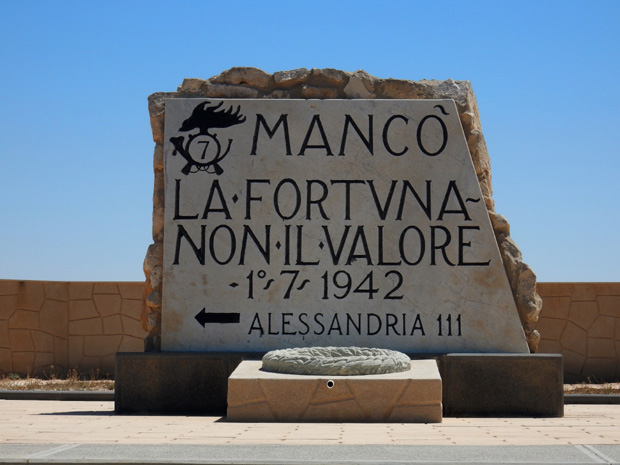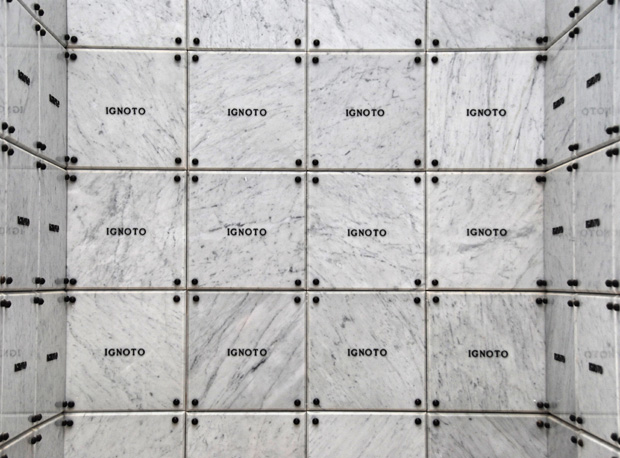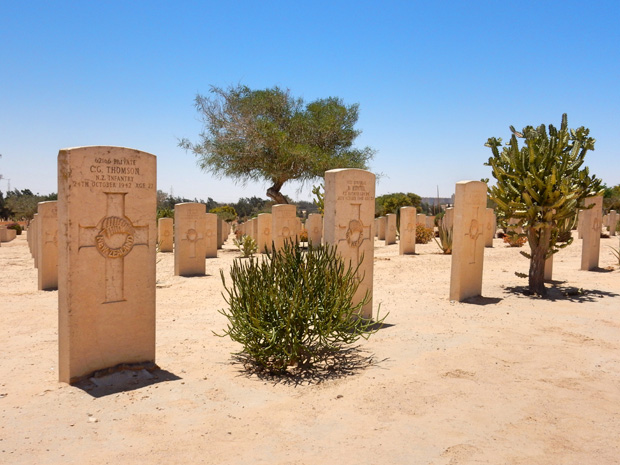Driving west along the coast road toward Marsa Matruh is a bizarre experience. For kilometers, after leaving Alexandria, sight of the sea is blocked by modern ‘international’ housing developments.
The seeming folly of building on this vast scale along the arid coastline somehow prepares the visitor for an equally surreal sight—a light tank in the middle of the road. However, this is a sure sign that we have reached a point just over 100km from Alexandria and a mere 240km northwest of Cairo named El Alamein.
It was here that the armies of the European Axis Powers (Germany and Italy) and the Allies (represented by contingents from Britain, India, South Africa, Australia, New Zealand, Canada, Greece, and the Free French), struggled—between July 1st and November 5th, 1942 — for mastery of North Africa. The battle of El Alamein proved to be one of the great turning points of WWII, and has been reassessed recently in El Alamein and the Struggle for North Africa edited by Jill Edwards.
By July 1942, the ‘Afrika Korps’ (Panzerarmee) had driven the Allied troops to this last defensible position before the Suez Canal. By then, the situation was so desperate for the Allies that the Italian fascist leader, Benito Mussolini, had already crossed over to Italian Libya in preparation for a triumphal entry into Cairo.
 ‘Lacking in luck, not in valor’ – The furthest point reached by the Italian Army.[/caption]
‘Lacking in luck, not in valor’ – The furthest point reached by the Italian Army.[/caption]
Yet the British General Staff had long recognized the potential of the ‘El Alamein Line’ as the best position to defend Egypt. The desert narrowed here to a 60km gap, bounded by the Mediterranean to the north and by the high escarpments of the Qattara Depression to the south. There was no other practical route into Egypt.
Both of the opposing generals in the first battle of El Alamein between 1st and 27th July — Claude Auchinleck and Erwin Rommel — were something of outsiders. Unlike his peers in the British army, Auchinleck was a career Indian Army officer who had seen service in the Great War in Mesopotamia, the Northwest Frontier, and Egypt. He knew the ground. His opponent, Erwin Rommel, unlike many of the officers at his rank, had not come from a great military or other high status German family. Yet, his service on the Western Front in WWI had shown him to be intelligent, brave, bold, and resourceful. Promotion had followed.
However, Rommel had a major character flaw: recklessness. A high rate of tank mobility was not matched by an equal care for extending air cover over progress made, and the depredations of the Royal Navy and Royal Air Force along the Afrika Korps’s supply lines meant that it did not, in fact, have enough fuel to reach Alexandria.
After three days of intense and confused fighting, it became clear that Auchinleck had managed to turn defeat into victory. The Afrika Korps was stranded in the desert without the resources to go forward or back.
By July 21st, the Panzerarmee had lost 70% of its soldiers and 85% of its armor. Yet, despite three major attempts, the Allied Eighth Army failed to destroy it.
As a result, the abrasive, tough and ruthless Bernard Montgomery, replaced Auchinleck, who had little political capital at home. Montgomery had learned his craft on the Western Front, and was consequently more prepared to accept substantial losses. He also possessed the political support to be able to stockpile sufficient resources over time to conduct a First World War style war of attrition.
 The remains of a British command post.[/caption]
The remains of a British command post.[/caption]
When Montgomery launched the second battle of El Alamein on October 23rd, 1942 — using a plan which had been originally formulated, ironically, by Auchinleck in August — he had twice as many soldiers, three times as many aircraft, and four times as many medium tanks as the Afrika Korps.
The final act—Operation Supercharge — continued through November 2nd and 3rd, and after November 4th Rommel had no option but to order a full-scale withdrawal in order to try to save the shattered remnants of the Afrika Korps.
After so many defeats, the turn in the tide in British fortunes and morale at home represented by the successful conflict at El Alamein seemed unforgettable, yet only a few years later it seemed only one of many milestones on the victory road. Perhaps, El Alamein’s true importance in hindsight — as one historian has put it — was that it enabled the British Empire to begin to go out with a little bit more of a bang than a whimper.
All that remains on the ground at El Alamein are the memorials to the fallen, and a vast complex of fortifications, trenches and diggings—most of it remaining inaccessible and under the care of the Egyptian Army, not least because of the risk of unexploded ordnance.
 ‘Unknown’. The Italian Cemetery.[/caption]
‘Unknown’. The Italian Cemetery.[/caption]
 The Commonwealth Cemetery.[/caption]
The Commonwealth Cemetery.[/caption]
However, there are plans to develop an El Alamein Battlefield Historic Park, which would, in the end, be a suitable tribute to the forces who fought here, and to a major turning point in the struggle for North Africa, and the Second World War.
Nigel Fletcher-Jones is director of the American University in Cairo Press. Join Nigel on Facebook here and browse the AUC Press website here.
Comments
Leave a Comment